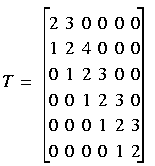





3.2 Defining Matrices
Once we understand vectors, the next most important abstraction in linear algebra is the concept of a linear mapping from one vector space to another. Since we are concerned only with vectors of finite dimension, such a mapping can always be represented using a matrix of coefficients. If x is a vector from one space, and y is a vector from another, we can represent a linear mapping from x to y as y=Ax, where A is a matrix, and Ax is an inner product. Often, the matrix A has some special structure; for example, it may be banded or symmetric.
LAPACK.h++ has classes for many different matrix types. Each matrix type has a similar interface, so if you learn one, learning the others is easy. To give you a feel for using a matrix type, here is a simple example using a tridiagonal matrix class:
#include <rw/ftrdgmat.h> // 1
#include <iostream.h>
main()
{
FloatTriDiagMat T(6,6); // 2
T.zero();
T.diagonal(0) = 2; // 3
T.diagonal(-1) = 1;
T.diagonal(1) = 3;
T(1,2) = 4; // 4
RWMathVec<float> x = " [ 2 3 9 8 3 0 ] ";
RWMathVec<float> Tx = product(T,x); // 5
cout << T << endl;
cout << x << endl;
cout << Tx << endl;
}
| //1 | The first line declares the class FloatTriDiagMat as a new C++ type by including the Rogue Wave header file ftrdgmat.h. A variable of type FloatTriDiagMat represents a tridiagonal matrix of floating point numbers. A tridiagonal matrix is a matrix where all the entries are 0, except for the entries on the main diagonal, and the entries immediately above and below the main diagonal.
|
| //2 | This line defines T to be an uninitialized 6 x 6 tridiagonal matrix; the next line sets all of its entries to 0.
|
| //3 | Here we use the diagonal function to set the entire main diagonal to 2. The next two lines set the other two nonzero diagonals to 1 and 3.
|
| //4 | In this line, we use subscripting to access a particular element of the matrix and change it. The matrix is set up as follows:
|

